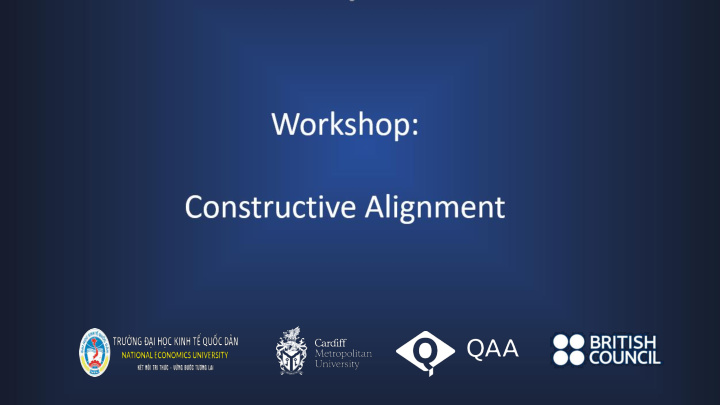



Aims of Session • Understand the concept of constructive alignment • Identify the benefits of constructive alignment • Consider examples of how constructive alignment can enhance the learning and teaching environment
Constructive Alignment Intro Constructive alignment has played an important role in how UK higher education programmes are designed The premise behind constructive alignment is that learning and teaching activities relate directly to the intended learning outcomes and the assessment tasks – Biggs and Tang, 2011 There are a number of external influences that include: subject benchmark statements; frameworks for HE qualifications; professional statutory regulatory bodies; institutional drivers
Constructive Alignment It starts with the notion that the learner constructs his / her own learning through relevant learning activities The role of the teacher / lecturer is to create a learning environment that supports the learning activities appropriate to achieving the desired / intended learning outcomes By aligning the learning outcomes, learning activities and assessment, ‘the learner finds it difficult to escape without learning appropriately.’
Constructive Alignment Constructive refers to how students 1. Defining the Intended construct meaning – and this must Learning Outcomes (ILOs) be achieved by the learner 2. Choosing activities that will lead to the ILOs Alignment refers to what the teacher 3. Assessing students actual does in setting up the components learning opposite 4. Arriving at a final grade
Constructive Alignment Class Activities Are these perceived as equal: (i) Learners (ii) Lecturers Students as Partners Assessment Intended Learning Outcomes See: Adapted from Biggs
Workshop activity Work in small groups and use the module descriptor, teaching activities and assessment examples to ask the question: Do the learning outcomes, assessment and teaching align to enable effective student learning? Are there ways in which this could be improved? Note to participants – the purpose is to offer constructive feedback and act as critical friends to each other
Discussion
Developing Constructive Alignment • Key requirements 1. Practice 2. Practise 3. Variation
Surface or Deep Learning Surface learning – associated with acceptance, memorisation, and surface retention of information Deep learning – associated with understanding, connecting concepts and critical analysis
Terminology Can you define the following: Knowledge Application Evaluation Comprehension Synthesis Analysis Can you rank them in order of importance?
Defining Terminology Knowledge: evidence, the source material – Consider written material, numerical data etc Application: of the evidence of your understanding – Consider processing content of existing knowledge Evaluation: judgement of others’ work arguments – Consider strengths, weaknesses, drawing out a position Comprehension: understanding and contextualising your evidence – Consider looking for patterns, messages Synthesis: formulation of your own ideas based on others’ work – Consider conclusions, theories Analysis: evidence of data, others’ evidence – Consider component parts, comparisons and contrasts
Known as Bloom’s Taxonomy Evaluation Synthesis Analysis Application Comprehension Knowledge
Summary of Workshop
Recommend
More recommend